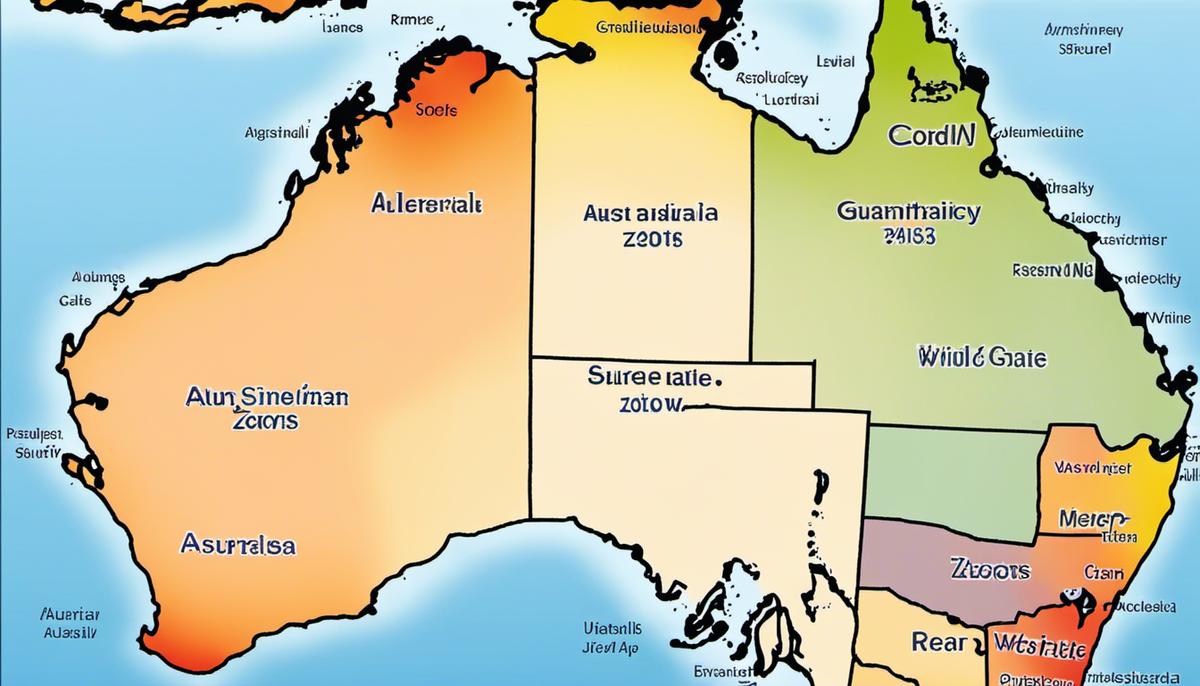Australia, a vibrant land of dramatic contrasts, boasts a myriad of unique climates, each shaping the environment and ecosystems like notes in a symphony. From the scorching desert sands to the lush subtropical rainforests, the frosty peaks of Tasmania to the balmy beaches of Queensland, the Australian climate plays a crucial role in the country’s biodiversity, agriculture, and sustainability.
Understanding the varied Australian climate zones is paramount to grasp how extreme weather events, accentuated by climate change, affect its wildlife, ecosystems, and farming sector. Moreover, the impact of policy decisions, mitigation efforts, and international agreements made by Australia’s government are deeply rooted in the country’s unique weather patterns and looming climate concerns.
Understanding Australian Climate Zones
Australia’s Climate Zones
Australia’s climate is greatly influenced by ocean temperatures, creating a variety of climate zones. These include tropical, subtropical, desert, and temperate zones, all of which characterize unique weather patterns, average temperatures, and seasonal shifts.
Tropical Zone
Ensconced in the northernmost part of Australia, the tropical zone experiences a climate which can be split into two seasons: wet and dry. The wet season, from November to April, is characterized by high temperatures, strong winds, and heavy rainfall. Conversely, the dry season, from May to October, sees less rainfall and cooler temperatures in the mid-20 degrees Celsius. The tropical zone incorporates the northern parts of Western Australia, the Northern Territory’s Top End, and a northerly strip of Queensland.
Subtropical Zone
The subtropical zone includes the eastern coast and southeastern parts of the country. In this zone, pleasant temperatures averaging between 20-30 degrees Celsius can be expected through most of the year, with humidity levels rising notably in summer. Rainfall is spread fairly evenly throughout the year, but coastal areas often experience heavier showers during summer. Major cities within this zone include Brisbane, Sydney, and Adelaide.
Desert Zone
The interior of Australia is known as the desert zone, which is largely made up of arid and semi-arid lands. Average temperatures here can fluctuate wildly, with summer days reaching over 40 degrees Celsius and winter nights dipping below zero. Rainfall is sparse and unpredictable, often going months without significant rainfall, giving rise to its characteristic desert landscapes. Key landmarks in this zone include Alice Springs, Uluru, and the Outback regions.
Temperate Zone
The temperate zone stretches across the southern part of Australia, inclusive of Tasmania. This climate zone is home to four distinct seasons, with mild, typically warm summers (20-30 degrees Celsius), and cool, occasionally wet winters (10-15 degrees Celsius). The zone houses the cities of Melbourne, Adelaide, and Hobart. It is also responsible for a majority of Australia’s wine production as a result of its Mediterranean-like climate.
Australia’s climatic variations not only provides a wide range of experience for locals and vacationers, but they also support a collection of unique ecosystems, wildlife, and landscapes. It’s crucial to grasp these climate zones to fully appreciate the rich natural wonders, environmental and geological features of Australia. The climate zones in Australia and their projected shifts bear considerable influence on the development, agricultural activities, water resources, and undeniably, the overall socio-economic fabric of the nation.

Extreme Weather Events and Climate Change
Overview of Australia’s Extreme Weather Patterns
Australia is noticeable for its severe weather conditions, ranging from cyclones to intense heat waves, debilitating droughts, and ruinous bushfires. These acts of nature create significant obstacles, often resulting in loss of lives, property destruction, and substantial damage to local ecosystems.
Tropical Cyclones: Coastal havoc
Cyclones are one of the most prominent extreme weather events in Australia, particularly in the northern and northeastern coastal regions. Encompassing an in-depth scale of destruction, these intense systems often bring heavy rain, strong winds, and sometimes even cause disastrous storm surges. Coastal communities, infrastructure, and industries are frequently the most affected, with the potential for long-term ecological and socio-economic consequences.
Heatwaves and Droughts: A Land in Thirst
Heatwaves and droughts are another common occurrence in Australia. These usually span across large geographical regions and can last for considerably long durations. Persistent high temperatures and lower rainfall levels often lead to severe water shortages, agricultural challenges, wildfires, and significant strain on electricity grids due to increased use of air conditioning.
Bushfires: The Fiery Fury
Australian bushfires, also known as wildfires, are frequently fueled by the dry climatic conditions prevalent in the continent. These blazes, typically occurring during the hotter months, can devastate vast swathes of natural landscapes, decimate wildlife, destroy homes, and even claim lives. The smoke and particulate matter from these fires can also contribute to air pollution, posing additional health risks.
Climate Change Accelerating Extreme Events
Climate change is widely recognized as a key factor amplifying the severity and frequency of these extreme weather events. Rising global temperatures, altered rainfall patterns, and increasing sea levels are all contributing to more intense cyclones, longer and hotter heatwaves, worsening drought conditions, and more severe bushfires. For example, the 2019-2020 ‘Black Summer’ bushfires in Australia were reported to be significantly exacerbated by human-induced climate change.
Anticipating Tomorrow in Australia
Current projections indicate a worrying increase in the severity and frequency of climatic events impacting Australia in the not-too-distant future. We can expect more common heatwaves, longer spells of drought, and intensifying bushfire risks. Cyclones may occur less frequently, but their intensity could be greater. Facing such a future only emphasizes the importance of developing effective strategies to adapt to climate change and of reducing global greenhouse gas emissions. Although the challenge may appear overwhelming, the resilience and adaptability inherent to the Australian community, along with advancements in climate science, give hope for a future where the effects of these harsh events can be managed effectively.

Impacts of Climate on Australian Wildlife and Ecosystem
Diversity of Climate in Australia: Effects on Wildlife and Botanical Life
Commonly referred to as the ‘Land Down Under’, Australia is distinguished by an array of diverse climate zones. These range from tropical monsoons in the north, to arid deserts inland, and temperate climates in the southeastern regions. The distinctive array of botanical life and wildlife found only in Australia have their origins and survival tied closely to these diversified climatic conditions.
Flora: Adaptations to Extreme Variations in Climate
The Australian flora has evolved to survive the country’s harsh climate conditions, which include severe droughts in the desert region and heavy torrential rains in the tropical north. Some plants have developed thick hard leaves to prevent water loss, while others such as the desert-dwelling Spinifex, have long roots to reach underground water sources. The iconic Eucalyptus trees, synonymous with the Australian landscape, have tough leaves that resist the scorching summer heat and are fire-resistant, an adaptation to the country’s frequent bushfires.
Fauna: Extreme Adaptations for Survival
Animals in Australia have also undergone distinct adaptations for survival. For instance, marsupials such as kangaroos, koalas, and wombats have adapted to Australia’s hot desert-like conditions with extreme heat and sparse vegetation, while crocodiles and many bird species thrive in the wet tropical regions of the north. Some species like the dingo, have adapted to a wide range of Australian climates, inhabiting both deserts and grasslands.
Climate Change: A Growing Threat to Australia’s Ecosystems
However, the continued diversification and survival of Australia’s ecosystems are under threat due to ongoing climate changes. The rise in average temperatures, extreme weather events, and shifting precipitation patterns are negatively impacting different ecosystems across the country.
Impact on Flora
Increasing temperatures and extended periods of drought are making it difficult for plants to survive, especially in already hot and dry conditions such as those found in central Australia. Bushfires, worsened by hotter and drier conditions, also pose severe threats to forests and woodlands, reducing biodiversity and contributing to the endangerment of many plant species.
Impact on Fauna
Similarly, climate change is significantly affecting Australia’s fauna. Rising temperatures are making habitats inhabitable for many species. For instance, heatwaves have resulted in mass die-offs of flying-foxes, whose insulated fur makes them vulnerable to heat stress. Changes in sea temperatures are also being linked to declining numbers of marine species, including the iconic Great Barrier Reef corals.
Endangered Ecosystems
Ecosystems such as the Great Barrier Reef and the iconic wetlands of Kakadu National Park are of particular concern. Increased temperatures, combined with more acidic ocean conditions due to higher carbon dioxide levels, are causing widespread coral bleaching in the Reef. In Kakadu, rising sea levels are intruding upon freshwater wetlands, altering the delicate balance of these ecosystems.
Australia hosts a diverse range of climates and environments, each fostering unique biodiversity. From lush rainforests to arid terrains, the Australian climate impacts the survival and evolution of various distinctive species. The growing concern regarding climate change and its effects highlights the necessity for effective solutions to protect and sustain this biodiversity.

Climate’s Role in Australia’s Agriculture
Climate Influence on Australian Agriculture
Australia’s varied climate conditions, spanning from lush rainforests to dry deserts, support an array of agricultural activities. This diversity contributes significantly to making agriculture a primary economic driver in the country.
The impact of the climate on Australia’s agricultural production is evident in different regions. The temperate regions of Victoria, Southern New South Wales, and Tasmania, characterized by cold, wet winters, excel in dairy farming and apple production. These areas are also crucial for wheat cultivation.
In contrast, the arid regions, like the Murray-Darling Basin and certain areas of New South Wales, showcase the resiliency of Australian farmers, who leverage crops and livestock suited to such conditions. You’ll find the famous merino sheep here, known for their fine wool. Moreover, areas depending on water from the Murray and Darling rivers produce rice, cotton, and wheat abundantly.
The tropical zones of Northern Queensland and Northern Territory benefit from a year-round growing season. This climate supports the cultivation of sugarcane, bananas, mangos, pineapples, and a variety of other tropical fruits and vegetables.
Climate Change Effects on Australian Agriculture
Climate change is becoming a significant issue for Australian agriculture, with increasing temperatures, varying rainfall patterns, and more extreme weather events anticipated to pressure agricultural activities. These changes will likely affect dairy farming in Australia’s temperate regions as cattle are drastically affected by heat stress which impacts their milk yield. Moreover, frequent droughts could limit the water available for crop and livestock irrigation, especially in arid regions.
Similarly, Australia’s fruit and vegetable sector could experience threats to productivity due to these climatic shifts. Changing temperatures and extreme weather could disrupt crop-growing seasons and yields. Because of this, steps are being taken to mitigate the potential impacts of climate change on this essential industry.
Adjustment strategies comprise implementing climate-resilient agricultural practices such as drought-resistant crops, precision farming methods, and efficient irrigation systems. Farmers are also considering switching to more climate-appropriate crop types and livestock, altering planting and harvesting schedules to match changing weather patterns, and increasing on-site biodiversity to enhance resilience.
In conclusion, while the climate in Australia plays a significant part in determining the types of agriculture viable in different regions, climate change presents significant challenges to this crucial industry, it also brings the possibility for growth and innovation.

Climate Policies and Mitigation Efforts in Australia
International Climate Change Commitments Made by Australia
As part of the global community, Australia has made commitments under various international agreements to fight climate change. Under the most prominent of these, the Paris Agreement, the nation has pledged to decrease its greenhouse gas emissions by 26-28% from 2005 levels by the year 2030. Australia has also made commitments under the Kyoto Protocol and actively takes part in the United Nations Framework Convention on Climate Change (UNFCCC).
Efforts to Reduce Greenhouse Gas Emissions
Australia is taking several measures to reduce its greenhouse gas emissions. These include transitioning to renewable energy sources, improving energy efficiency, and adapting land use practices. The Renewable Energy Target (RET) is a major federal policy aiming to increase Australia’s renewable energy use. The RET aims to ensure 23.5% of Australia’s electricity comes from renewable sources by 2020. Beyond this, states and territories have individual renewable energy targets, many of which are more ambitious than the federal target.Carbon Pricing and Emission Trading Scheme
Australia was one of the first countries in the world to introduce a carbon tax in 2012, which was later replaced by an Emissions Reduction Fund in 2014. This program provides incentives for businesses to reduce their emissions. While the efficacy of these programs has been a point of contention, they represent examples of how Australia is integrating climate change mitigation into its economic and policy frameworks.Furthermore, Australia has been exploring market-based approaches to reduce its emissions, such as an Emissions Trading Scheme (ETS). The government has made efforts to link its ETS with those of other countries to create a more effective international carbon market.
Climate Change Impacts and Response
Australia is already experiencing the impacts of climate change, including higher temperatures, sea-level rise, and an increase in the frequency and intensity of bushfires and cyclones. These impacts pose significant risks to the country’s communities, economy, and natural ecosystems.To deal with these challenges, Australia has developed various climate change adaptation initiatives. The National Climate Resilience and Adaptation Strategy provides a framework for managing the country’s climate risks. Australia has also invested in infrastructure to deal with the impacts of climate change, such as seawalls to protect against sea-level rise, and bushfire management programs.
Furthermore, the Australian government established the Climate Change Authority, an independent agency providing expert advice on climate change policy and future emission reduction targets.
Finally, investments are being made in research to understand the impacts of climate change on Australia’s iconic species and ecosystems, such as the Great Barrier Reef, and develop strategies to help them adapt.
Public and Private Sector Initiatives
Both the public and private sectors in Australia have taken significant steps to address climate change. Many local governments have declared a climate emergency, committing to various mitigation and adaptation measures.Moreover, many Australian companies are also taking action, with an increasing number committing to net-zero emissions targets, often ahead of the Australian government’s timeline. These companies are investing in renewable energy, implementing energy efficiency measures, and researching and developing new technologies to reduce emissions.

As Australia stands at the paradoxical intersection of being both a victim and a contributor to global climate change, it is pivotal to stay informed about its climate and its implications. From influencing agriculture and wildlife to dictating extreme weather patterns and affecting policies and mitigation efforts, Australia’s climate has a far-reaching impact. Thus, keeping abreast of the Australian climates will not only improve our understanding of the land down under but will also illuminate the implications of climate change, reinforcing the importance of sustainable actions for a brighter and more sustainable future in Australia and beyond.






